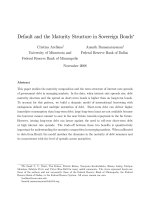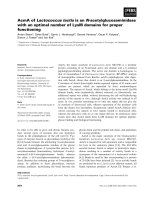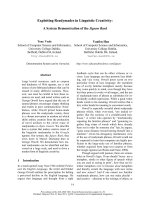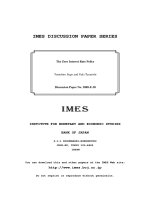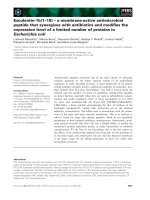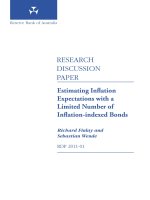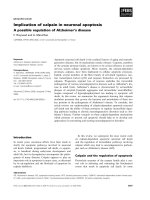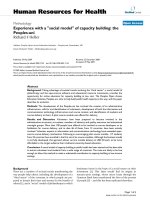RESEARCH DISCUSSION PAPER: Estimating Infl ation Expectations with a Limited Number of Infl ation-indexed Bonds doc
Bạn đang xem bản rút gọn của tài liệu. Xem và tải ngay bản đầy đủ của tài liệu tại đây (479.31 KB, 39 trang )
Reserve Bank of Australia
Reserve Bank of Australia
Economic Research Department
2011-01
RESEARCH
DISCUSSION
PAPER
Estimating Infl ation
Expectations with a
Limited Number of
Infl ation-indexed Bonds
Richard Finlay and
Sebastian Wende
RDP 2011-01
ESTIMATING INFLATION EXPECTATIONS WITH A
LIMITED NUMBER OF INFLATION-INDEXED BONDS
Richard Finlay and Sebastian Wende
Research Discussion Paper
2011-01
March 2011
Economic Research Department
Reserve Bank of Australia
The authors thank Rudolph van der Merwe for help with the central difference
Kalman filter, as well as Adam Cagliarini, Jonathan Kearns, Christopher Kent,
Frank Smets, Ian Wilson and an anonymous referee for useful comments and
suggestions, and Mike Joyce for providing UK data. Responsibility for any
remaining errors rests with the authors. The views expressed in this paper are those
of the authors and are not necessarily those of the Reserve Bank of Australia.
Author: finlayr at domain rba.gov.au
Media Office:
Abstract
We estimate inflation expectations and inflation risk premia using inflation
forecasts from Consensus Economics and Australian inflation-indexed bond price
data. Inflation-indexed bond prices are assumed to be non-linear functions of latent
factors, which we model via an affine term structure model. We solve the model
using a non-linear Kalman filter. While our results should not be interpreted too
precisely due to data limitations and model complexity, they nonetheless suggest
that long-term inflation expectations are well anchored within the 2 to 3 per cent
inflation target range, while short-run inflation expectations are more volatile and
more closely follow contemporaneous inflation. Further, while long-term inflation
expectations are generally stable, inflation risk premia are much more volatile.
This highlights the potential benefits of our measures over break-even measures
of inflation which include both components.
JEL Classification Numbers: E31, E43, G12
Keywords: inflation expectations, inflation risk premia, affine term structure
model, break-even inflation, non-linear Kalman filter
i
Table of Contents
1. Introduction 1
2. Model 3
2.1 Yields and Forward Rates 3
2.2 Affine Term Structure Model 4
2.3 Pricing Inflation-indexed Bonds in the Latent Factor Model 6
2.4 Inflation Forecasts in the Latent Factor Model 7
3. Data and Model Implementation 7
3.1 Data 7
3.2 The Kalman Filter and Maximum Likelihood Estimation 10
3.3 Calculation of Model Estimates 11
4. Results 11
4.1 Model Parameters and Fit to Data 11
4.2 Qualitative Discussion of Results 13
4.2.1 Inflation expectations 13
4.2.2 Inflation risk premia 15
4.2.3 Inflation forward rates 17
4.2.4 Comparisons with other studies 18
5. Discussion and Conclusion 19
Appendix A: Yields and Stochastic Discount Factors 23
Appendix B: The Mathematics of Our Model 27
Appendix C: Central Difference Kalman Filter 31
References 34
ii
ESTIMATING INFLATION EXPECTATIONS WITH A
LIMITED NUMBER OF INFLATION-INDEXED BONDS
Richard Finlay and Sebastian Wende
1. Introduction
Reliable and accurate estimates of inflation expectations are important to central
banks given the role of these expectations in influencing inflation and economic
activity. Inflation expectations may also indicate over what horizon individuals
believe that a central bank will achieve its inflation target, if at all.
The difference between the yields on nominal and inflation-indexed bonds,
referred to as the inflation yield or break-even inflation, is often used as a measure
of inflation expectations.
1
Since nominal bonds are not indexed to inflation,
investors in these bonds require higher yields, relative to those available on
inflation-indexed bonds, as compensation for inflation. The inflation yield may
not give an accurate reading of inflation expectations, however. This is because
investors in nominal bonds will likely demand a premium, over and above their
inflation expectations, for bearing inflation risk. That is, the inflation yield will
include a premium that will depend positively on the extent of uncertainty about
future inflation. If we wish to estimate inflation expectations we must separate this
inflation risk premia from the inflation yield. By treating inflation as a random
process, we are able to model expected inflation and the cost of the uncertainty
associated with inflation separately.
Inflation expectations and inflation risk premia have been estimated for the
United Kingdom and the United States using models similar to the one used
in this paper. Beechey (2008) and Joyce, Lildholdt and Sorensen (2010) find
that inflation risk premia decreased in the UK, first after the Bank of England
adopted an inflation target and then again after it was granted independence. Using
US Treasury Inflation-Protected Securities (TIPS) data, Durham (2006) estimates
expected inflation and inflation risk premia, although he finds that inflation risk
1 The income stream from an inflation-indexed bond is adjusted by the rate of inflation and
maintains its value in real terms. Terms and conditions of Treasury inflation-indexed bonds
are available at />2
premia are not significantly correlated with measures of the uncertainty of future
inflation or monetary policy. Also using TIPS data, D’Amico, Kim and Wei (2008)
find inconsistent results due to the decreasing liquidity premia in the US, although
their estimates are improved by including survey forecasts and using a sample over
which the liquidity premia are constant.
In this paper we estimate a time series for inflation expectations for Australia at
various horizons, taking into account inflation risk premia, using a latent factor
affine term structure model which is widely used in the literature. Compared to
the United Kingdom and the United States, there are a very limited number of
inflation-indexed bonds on issue in Australia. This complicates the estimation but
also highlights the usefulness of our approach. In particular, the limited number
of inflation-indexed bonds means that we cannot reliably estimate a zero-coupon
real yield curve and so cannot estimate the model in the standard way. Instead, we
develop a novel technique that allows us to estimate the model using the price of
coupon-bearing inflation-indexed bonds instead of zero-coupon real yields. The
estimation of inflation expectations and risk premia for Australia, as well as the
technique we employ to do so, are the chief contributions of this paper to the
literature.
To better identify model parameters we also incorporate inflation forecasts
from Consensus Economics in the estimation. Inflation forecasts provide shorter
maturity information (for example, forecasts exist for inflation next quarter), as
well as information on inflation expectations that is separate from risk premia.
Theoretically the model is able to estimate inflation expectations and inflation risk
premia purely from the nominal and inflation-indexed bond data – inflation risk
premia compensate investors for exposure to variation in inflation, which should
be captured by the observed variation in prices of bonds at various maturities.
This is, however, a lot of information to extract from a limited amount of bond
data. Adding forecast data helps to better anchor the model estimates of inflation
expectations and so improves model fit.
Inflation expectations as estimated in this paper have a number of advantages
over using the inflation yield to measure expectations. For example, 5-year-ahead
inflation expectations as estimated in this paper (i) account for risk premia and
(ii) can measure expectations of the inflation rate in five years time (as well as
the average expectation over the next five years). In contrast, the 5-year inflation
3
yield ignores risk premia and only gives an average of inflation rates over the
next five years.
2
The techniques used in the paper are potentially useful for other
countries with a limited number of inflation-indexed bonds on issue, such as
Germany or New Zealand.
In Section 2 we outline the model. Section 3 describes the data, estimation
of the model parameters and latent factors, and how these are used to extract
our estimates of inflation expectations. Results are presented in Section 4 and
conclusions are drawn in Section 5.
2. Model
2.1 Yields and Forward Rates
To make subsequent discussion clear we first briefly define yields and forward
rates in our model. Unless otherwise stated, yields in this paper are gross, zero-
coupon and continuously compounded. So, for example, the nominal τ-maturity
yield at time t is given by y
n
t,τ
= −log(P
n
t,τ
) where P
n
t,τ
is the price at time t of
a zero-coupon nominal bond paying one dollar at time t + τ. The equivalent real
yield is given by y
r
t,τ
= −log(P
r
t,τ
) where P
r
t,τ
is the price at time t of a zero-coupon
inflation-indexed bond, which pays the equivalent of the value one time t dollar at
time t +τ.
3
The inflation yield is the difference between the yields of nominal and
inflation-indexed zero-coupon bonds of the same maturity. So the inflation yield
between time t and t + τ is
y
i
t,τ
= y
n
t,τ
−y
r
t,τ
.
The inflation yield describes the cumulative increase in prices over a period. In
continuous time, the inflation yield between t and t + τ is related to the inflation
forward rates applying over that period by
y
i
t,τ
=
ˆ
t+τ
t
f
i
t,s
ds
2 In addition, due to the lack of zero-coupon real yields in Australia’s case, yields-to-maturity
of coupon-bearing nominal and inflation-indexed bonds have historically been used when
calculating the inflation yield. This restricts the horizon of inflation yields that can be estimated
to the maturities of the existing inflation-indexed bonds, and is not a like-for-like comparison
due to the differing coupon streams of inflation-indexed and nominal bonds.
3 These are hypothetical constructs as zero-coupon government bonds are not issued in Australia.
4
where f
i
t,s
is the instantaneous inflation forward rate determined at time t and
applying at time s.
4
2.2 Affine Term Structure Model
Following Beechey (2008), we assume that the inflation yield can be expressed
in terms of an inflation Stochastic Discount Factor (SDF). The inflation SDF
is a theoretical concept, which for the purpose of asset pricing incorporates all
information about income and consumption uncertainty in our model. Appendix A
provides a brief overview of the inflation, nominal and real SDFs.
We assume that the inflation yield can be expressed in terms of an inflation SDF,
M
i
t
, according to
y
i
t,τ
= −log
E
t
M
i
t+τ
M
i
t
.
We further assume that the evolution of the inflation SDF can be approximated by
a diffusion equation,
dM
i
t
M
i
t
= −π
i
t
dt −λ
λ
λ
i
t
dB
t
. (1)
According to this model, E
t
(dM
i
t
/M
i
t
) = −π
i
t
dt, so that the instantaneous inflation
rate is given by π
i
t
. The inflation SDF also depends on the term λ
λ
λ
i
t
dB
t
. Here
B
t
is a Brownian motion process and λ
λ
λ
i
t
relates to the market price of this risk.
λ
λ
λ
i
t
determines the risk premium and this set-up allows us to separately identify
inflation expectations and inflation risk premia. This approach to bond pricing is
standard in the literature and has been very successful in capturing the dynamics
of nominal bond prices (see Kim and Orphanides (2005), for example).
We model both the instantaneous inflation rate and the market price of inflation
risk as affine functions of three latent factors. The instantaneous inflation rate is
4 At time t, the inflation forward rate at time s > t, f
i
t,s
, is known as it is determined by known
inflation yields. The inflation rate, π
i
s
, that will prevail at s is unknown, however, and in
our model is a random variable (π
i
s
can be thought of as the annualised increase in the CPI
at time s over an infinitesimal time period). π
i
s
is related to the known inflation yield by
exp(−y
i
t,τ
) = E
t
(exp(−
´
t+τ
t
π
i∗
s
ds)) so that y
i
t,τ
= −log(E
t
(exp(−
´
t+τ
t
π
i∗
s
ds))), where π
i∗
s
is
the so-called ‘risk-neutral’ version of π
i
s
(see Appendix B for details).
5
given by
π
i
t
= ρ
0
+ ρ
ρ
ρ
x
t
(2)
where x
t
= [x
1
t
,x
2
t
,x
3
t
]
are our three latent factors.
5
Since the latent factors are
unobserved, we normalise ρ
ρ
ρ to be a vector of ones, 1, so that the inflation rate
is the sum of the latent factors and a constant, ρ
0
. We assume that the price of
inflation risk has the form
λ
λ
λ
i
t
= λ
λ
λ
0
+ Λx
t
(3)
where λ
λ
λ
0
is a vector and Λ is a matrix of free parameters.
The evolution of the latent factors x
t
is given by an Ornstein-Uhlenbeck process
(a continuous time mean-reverting stochastic process)
dx
t
= K(µ
µ
µ −x
t
)dt + Σ dB
t
(4)
where: K(µ
µ
µ −x
t
) is the drift component; K is a lower triangular matrix; B
t
is the
same Brownian motion used in Equation (1); and Σ is a diagonal scaling matrix.
In this instance we set µ
µ
µ to zero so that x
t
is a zero mean process, which implies
that the average instantaneous inflation rate is ρ
0
.
Equations (1) to (4) can be used to show that the inflation yield is a linear function
of the latent factors (see Appendix B for details). In particular
y
i
t,τ
= α
∗
τ
+ β
β
β
∗
τ
x
t
(5)
where α
∗
τ
and β
β
β
∗
τ
are functions of the underlying model parameters. In the
standard estimation procedure, when a zero-coupon inflation yield curve exists,
this function is used to estimate the values of x
t
.
5 Note that one can specify models in which macroeconomic series take the place of latent
factors, as done for example in Hördahl (2008). Such models have the advantage of simpler
interpretation but, as argued in Kim and Wright (2005), tend to be less robust to model
misspecification and generally result in a worse fit of the data.
6
2.3 Pricing Inflation-indexed Bonds in the Latent Factor Model
We now derive the price of an inflation-indexed bond as a function of the model
parameters, the latent factors and nominal zero-coupon bond yields, denoted
H1(x
t
). This function will later be used to estimate the model as described in
Section 3.2.
As is the case with any bond, the price of an inflation-indexed bond is the present
value of its stream of coupons and its par value. In an inflation-indexed bond,
the coupons are indexed to inflation so that the real value of the coupons and
principal is preserved. In Australia, inflation-indexed bonds are indexed with a
lag of between 4½ and 5½ months, depending on the particular bond in question.
This means that for future indexations part of the change in the price level has
already occurred, while part is yet of occur. We denote the time lag by ∆ and the
historically observed increase in the price level between t −∆ and t by I
t,∆
. Then
at time t, the implicit nominal value of the coupon paid at time t + τ
s
is given by
the real (at time t −∆) value of that coupon, C
s
, adjusted for the historical inflation
that occurred between t −∆ and t, I
t,∆
, and adjusted by the current market-implied
change in the price level between periods t and t +τ
s
−∆ using the inflation yield,
exp(y
i
t,τ
s
−∆
). So the implied nominal coupon paid becomes C
s
I
t,∆
exp(y
i
t,τ
s
−∆
). The
present value of this nominal coupon is then calculated using the nominal discount
factor between t and t +τ
s
, exp(−y
n
t,τ
s
). So if an inflation-indexed bond pays a total
of m coupons, where the par value is included in the last of these coupons, then
the price at time t of this bond is given by
P
r
t
=
m
s=1
C
s
I
t,∆
e
y
i
t,τ
s
−∆
e
−y
n
t,τ
s
=
m
s=1
C
s
I
t,∆
e
y
i
t,τ
s
−∆
−y
n
t,τ
s
.
We noted earlier that the inflation yield is given by y
i
t,τ
= α
∗
τ
+ β
β
β
∗
τ
x
t
so the bond
price can be written as
P
r
t
=
m
s=i
C
s
I
t,∆
e
−y
n
t,τ
s
+α
∗
τ
s
−∆
+β
β
β
∗
τ
s
−∆
x
t
= H1(x
t
). (6)
Note that exp(−y
n
t,τ
s
) can be estimated directly from nominal bond yields (see
Section 3.1). So the price of a coupon-bearing inflation-indexed bond can be
expressed as a function of the latent factors x
t
as well as the model parameters,
7
nominal zero-coupon bond yields and historical inflation. We define H1(x
t
) as the
non-linear function that transforms our latent factors into bond prices.
2.4 Inflation Forecasts in the Latent Factor Model
In the model, inflation expectations are a function of the latent factors, denoted
H2(x
t
). Inflation expectations are not equal to expected inflation yields since
yields incorporate risk premia whereas forecasts do not. Inflation expectations as
reported by Consensus Economics are expectations at time t of how the CPI will
increase between time s in the future and time s + τ and are therefore given by
E
t
exp
ˆ
s+τ
s
π
i
u
du
= H2(x
t
)
where π
i
t
is the instantaneous inflation rate at time t. In Appendix B we show that
one can express H2(x
t
) as
H2(x
t
) = exp(−
¯
α
τ
−
¯
β
β
β
τ
(e
−K(s−t)
x
t
+ (I −e
−K(s−t)
)µ
µ
µ) +
1
2
¯
β
β
β
τ
Ω
s−t
¯
β
β
β
τ
). (7)
The parameters
¯
α
τ
and
¯
β
β
β
τ
(and Ω
s−t
) are defined in Appendix B, and are similar
to α
∗
τ
and β
β
β
∗
τ
from Equation (5).
3. Data and Model Implementation
3.1 Data
Four types of data are used in this analysis: nominal zero-coupon bond yields
derived from nominal Australian Commonwealth Government bonds; Australian
Commonwealth Government inflation-indexed bond yields; inflation forecasts
from Consensus Economics; and historical inflation.
Nominal zero-coupon bond yields are estimated using the approach of Finlay
and Chambers (2009). These nominal yields correspond to y
n
t,τ
s
and are used
in computing our function H1(x
t
) from Equation (6). Note that the Australian
nominal yield curve has a maximum maturity of roughly 12 years. We extrapolate
nominal yields beyond this by assuming that the nominal and real yield curves
have the same slope. This allows us to utilise the prices of all inflation-indexed
bonds, which have maturities of up to 24 years (in practice the slope of the real
8
yield curve beyond 12 years is very flat, so that if we instead hold the nominal
yield curve constant beyond 12 years we obtain virtually identical results).
We calculate the real prices of inflation-indexed bonds using yield data.
6
Our
sample runs from July 1992 to December 2010, with the available data sampled at
monthly intervals up to June 1994 and weekly intervals thereafter. Bonds with less
than one year remaining to maturity are excluded. By comparing these computed
inflation-indexed bond prices, which form the P
r
t
in Equation (6), with our function
H1(x
t
), we are able to estimate the latent factors. We assume that the standard
deviation of the bond price measurement error is 4 basis points. This is motivated
by market liaison which suggests that, excluding periods of market volatility, the
bid-ask spread has stayed relatively constant over the period considered, at around
8 basis points. Some descriptive statistics for nominal and inflation-indexed bonds
are given in Table 1.
Table 1: Descriptive Statistics of Bond Price Data
Time period
Statistic 1992–1995 1996–2000 2001–2005 2006–2010
Number of bonds: nominal 12–19 12–19 8–12 8–14
inflation-indexed 3–5 4–5 3–4 2–4
Maximum tenor: nominal 11–13 11–13 11–13 11–14
inflation-indexed 13–21 19–24 15–20 11–20
Average outstanding: nominal 49.5 70.2 50.1 69.5
inflation-indexed 2.1 5.0 6.5 7.1
Notes: Tenor in years; outstandings in billions; only bonds with at least one year to maturity are included
Note that inflation-indexed bonds are relatively illiquid, especially in comparison
to nominal bonds.
7
Therefore, inflation-indexed bond yields potentially
incorporate liquidity premia, which could bias our results. As discussed we use
inflation forecasts as a measure of inflation expectations. These forecasts serve to
tie down inflation expectations, and as such we implicitly assume that liquidity
premia are included in our measure of risk premia. We also assume that the
6 Available from statistical table F16 at />7 Average yearly turnover between 2003/04 and 2007/08 was roughly $340 billion for nominal
Government bonds and $15 billion for inflation-indexed bonds, which equates to a turnover
ratio of around 7 for nominal bonds and 2½ for inflation-indexed bonds (see AFMA 2008).
9
existence of liquidity premia causes a level shift in estimated risk premia but does
not greatly bias the estimated changes in risk premia.
8
The inflation forecasts are taken from Consensus Economics. We use three types
of forecast:
1. Monthly forecasts of the average percentage change in CPI over the current
and the subsequent year.
2. Quarterly forecasts of the year-on-year percentage change in the CPI for
7 or 8 quarters in the future.
3. Biannual forecasts of the year-on-year percentage change in the CPI for
each of the next 5 years, as well as from 5 years in the future to 10 years in
the future.
We use the function H2(x
t
) to relate these inflation forecasts to the latent factors,
and use the past forecasting performance of the inflation forecasts relative to
realised inflation to calibrate the standard deviation of the measurement errors.
Historical inflation enters the model in the form of I
t,∆
from Section 2.3, but
otherwise is not used in estimation. This is because the fundamental variable
being modelled is the current instantaneous inflation rate. Given the inflation law
of motion (implicitly defined by Equations (2) to (4)), inflation expectations and
inflation-indexed bond prices are affected by current inflation and so can inform
our estimation. By contrast, the published inflation rate is always ‘old news’
from the perspective of our model and so has nothing direct to say about current
instantaneous inflation.
9
8 Inflation swaps are now far more liquid than inflation-indexed bonds and may provide
alternative data for use in estimating inflation expectations at some point in the future. Currently,
however, there is not a sufficiently long time series of inflation swap data to use for this purpose.
9 Note that our model is set in continuous time; data are sampled discretely but all quantities,
for example the inflation law of motion as well as inflation yields and expectations, evolve
continuously. π
i
t
from Equation (2) is the current instantaneous inflation rate, not a 1-month or
1-quarter rate.
10
3.2 The Kalman Filter and Maximum Likelihood Estimation
We use the Kalman filter to estimate the three latent factors using data on bond
prices and inflation forecasts. The Kalman filter can estimate the state of a dynamic
system from noisy observations. It does this by using information about how the
state evolves over time, as summarised by the state equation, and relating the
state to noisy observations using the measurement equation. In our case, the latent
factors constitute the state of the system and our bond prices and forecast data the
noisy observations. From the latent factors we are able to make inferences about
inflation expectations and inflation risk premia.
The standard Kalman filter was developed for a linear system. Although our state
equation (given by Equation (B1)) is linear, our measurement equations, using
H1(x
t
) and H2(x
t
) as derived in Sections 2.3 and 2.4, are not. This is because
we work with coupon-bearing bond prices instead of zero-coupon yields. We
overcome this problem by using a central difference Kalman filter, which is a
type of non-linear Kalman filter.
10
The approximate log-likelihood is evaluated using the forecast errors of the
Kalman filter. If we denote the Kalman filter’s forecast of the data at time t by
ˆ
y
t
ζ , x
t
(ζ , y
t−1
)
, which depends on the parameters (ζ ) and the latent factors
(x
t
(ζ , y
t−1
)), which in turn depend on the parameters and the data observed up to
time t −1 (y
t−1
), then the approximate log-likelihood is given by
L (ζ) = −
T
t=1
log|P
y
t
|+ (y
t
−
ˆ
y
t
)P
−1
y
t
(y
t
−
ˆ
y
t
)
.
Here the estimated covariance matrix of the forecast data is denoted by P
y
t
.
11
In
the model the parameters are given by ζ = (K,λ
λ
λ
0
,Λ,ρ
0
,Σ).
We numerically optimise the log-likelihood function to obtain parameter
estimates. From the parameter estimates, we use the Kalman filter to obtain
estimates of the latent factors.
10 See Appendix C for more detail on the central difference Kalman filter.
11 In actual estimation we exclude the first six months of data from the likelihood calculation to
allow ‘burn in’ time for the Kalman filter.
11
3.3 Calculation of Model Estimates
For a given set of model parameters and latent factors, we can calculate inflation
forward rates, expected future inflation rates and inflation risk premia.
In Appendix B we show that the expected future inflation rate at time t for time
t + τ can be expressed as
E
t
(π
i
t+τ
) = ρ
0
+ 1
e
−Kτ
x
t
.
The inflation forward rate at time t for time t + τ, f
i
t,t+τ
, is the rate of inflation at
time t +τ implied by market prices of nominal and inflation-indexed bonds trading
at time t. As bond prices incorporate inflation risk, so does the inflation forward
rate. In our model the inflation forward rate is given by
f
i
t,t+τ
=ρ
0
+ 1
(e
−K
∗
τ
x
t
+ (I −e
−K
∗
τ
)µ
µ
µ
∗
)
−
1
2
(1
(I −e
−K
∗
τ
)K
∗
−1
Σ)(1
(I −e
−K
∗
τ
)K
∗
−1
Σ)
.
See Appendix B for details on the above and definitions of K
∗
and µ
µ
µ
∗
.
The inflation risk premium is given by the difference between the inflation forward
rate, which incorporates risk aversion, and the expected future inflation rate, which
is free of risk aversion. The inflation risk premium at time t for time t +τ is given
by
f
i
t,t+τ
−E
t
(π
i
t+τ
).
4. Results
4.1 Model Parameters and Fit to Data
We estimate the model over the period 31 July 1992 to 15 December 2010
using a number of different specifications. First we estimate both two- and
three-factor versions of our model. Using a likelihood-ratio test we reject the
hypothesis that there is no improvement of model fit between the two-factor
model and three-factor model and so use the three-factor model. (Three factors are
usually considered sufficient in the literature, with, for example, the overwhelming
majority of variation in yields captured by the first three principal components.)
12
We also consider the three-factor model both with and without forecast data. Both
models are able to fit the inflation yield data well; the model without forecast
data, however, gives unrealistic estimates of inflation expectations and inflation
risk premia. The 10-year-ahead inflation expectations are implausibly volatile and
can be as high as 8 per cent and as low as −1 per cent, which is not consistent
with economists’ forecasts. These findings are consistent with those of Kim and
Orphanides (2005), where the use of forecast data is advocated as a means of
separating expectations from risk premia. Note, however, that estimates from the
model with forecast data are not solely determined by the forecasts; the model
estimates of expected future inflation only roughly match the forecast data and on
occasion deviate significantly from them, as seen in Figure 1.
Figure 1: Forecast Change in CPI
Over the next year
●
●
●
●
●
●
●
●
●
●
●
●
●
●
●
● ●
●
●
●
●
●
●
●
●
●
●
●
●
●
●
●
●
●
●
● ●
2.5
3.0
3.5
2.5
3.0
3.5
●
●
●
●
●
●
●
●
●
●
●
●
●
●
●
●
●
●
●
●
●●
●
●
●
●
●
●
●
●
●
●
●
●
●●
●
●
●
●
●
●
●
●
●
●
●
●
●
●
●
●●●
●
●
●
●●
●
●
●
●
●
●
●
●
●
●
●●●
2
3
4
5
2
3
4
5
Over 4th to 5th year
2006 2010200219981994
●
●
●
●
●
●
● ●
●
● ●
● ●
●
● ●
● ● ●
● ● ● ● ●
●
●
● ● ● ● ●
● ●
● ●
●
l l l l l l l l l l l l l l l l l
2.0
2.5
3.0
3.5
2.0
2.5
3.0
3.5
% %
Over 8th to 9th year
Consensus Economics
Model-generated
% %
% %
Over the next year
Sources: Consensus Economics; authors’ calculations
Our preferred model is thus the three-factor model estimated using forecast data.
Likelihood ratio tests indicate that two parameters of that model (Λ
11
and Λ
21
)
13
are statistically insignificant and so they are excluded. Our final preferred model
has 20 freely estimated parameters which are given in Table 2. We note that
the estimate of ρ
0
, the steady-state inflation rate in our model, is 2.6 per cent,
which is within the inflation target range. The persistence of inflation is essentially
determined by the diagonal entries of the K matrix, which drives the inflation law
of motion as defined by Equations (2) to (4). The first diagonal entry of K is 0.19,
which in a single-factor model would imply a half-life of the first latent factor
(being the time taken for the latent factor, and so inflation, to revert halfway back
to its mean value after experiencing a shock) of around 3½ years. The half-lives
of the other two latent factors would be 5 and 10 months.
Table 2: Parameter Estimates for Final Model
Model estimated 1992–2010
Index number (i)
Parameter 1 2 3
ρ
0
2.64 (0.26) na na
(K)
1i
0.19 (0.02) 0 0
(K)
2i
−2.88 (0.05) 1.75 (0.05) 0
(K)
3i
1.11 (0.05) 1.74 (0.05) 0.80 (0.01)
(Σ)
ii
0.11 (0.02) 1.51 (0.10) 0.96 (0.02)
λ
λ
λ
0,i
0.12 (0.01) 0.10 (0.01) −0.01 (0.00)
(Λ)
1i
0 55.44 (0.32) 15.31 (0.06)
(Λ)
2i
0 −107.80 (0.26) −8.91 (0.06)
(Λ)
3i
−12.38 (0.08) −144.22 (0.45) −73.07 (0.20)
Notes: ρ
0
and (Σ)
ii
are given in percentage points. Standard errors are shown in parentheses.
4.2 Qualitative Discussion of Results
4.2.1 Inflation expectations
Our estimated expected future inflation rates at horizons of 1, 5 and 10 years
are shown in Figure 2. Two points stand out immediately: 1-year-ahead inflation
expectations are much more volatile than 5- and 10-year-ahead expectations and,
as may be expected, are strongly influenced by current inflation (not shown);
and longer-term inflation expectations appear to be well anchored within the
2 to 3 per cent target range.
14
Figure 2: Expected Inflation Rate
l l l l l l l l l l l l l l l l l
1.5
2.0
2.5
3.0
3.5
4.0
4.5
1.5
2.0
2.5
3.0
3.5
4.0
4.5
1-year
%
5-year
10-year
2010
%
2006200219981994
We see that there is a general decline in inflation expectations from the beginning
of the sample until around 1999, the year before the introduction of the Goods and
Services Tax (GST). The estimates suggest that the introduction of the GST on
1 July 2000 resulted in a large one-off increase in short-term inflation expectations.
This is reflected in the run-up in 1-year-ahead inflation expectations over calendar
year 1999, although the peak in the estimated expectations is below the actual
peak in year-ended CPI growth of 6.1 per cent.
12
Of particular interest, however,
is the non-responsiveness of 5- and 10-year-ahead expectations, which should be
the case if the inflation target is seen as credible.
Long-term expectations increased somewhat between mid 2000 and mid 2001,
perhaps prompted by easier monetary conditions globally as well as relatively high
inflation in Australia. Interestingly, there appears to have been a sustained general
rise in inflation expectations between 2004 and 2008 at all horizons. Again this
was a time of rising domestic inflation, strong world growth, a boom in the terms
of trade and rising asset prices.
12 The legislation introducing the GST was passed through Federal Parliament in June 1999.
15
In late 2008 the inflation outlook changed and short-term inflation expectations
fell dramatically, likely in response to expectations of very weak global demand
caused by the financial crisis. Longer-term expectations also fell, before rising
over the early part of 2009 as authorities responded to the crisis. The subsequent
moderation of longer-term expectations, as well as the relative stabilisation of
short-term expectations, over 2010 suggests that financial market participants
considered the economic outlook and Australian authorities’ response to the crisis
sufficient to maintain inflation within the target range.
The latest data, corresponding to December 2010, show 1-year-ahead inflation
expectations reaching 3 per cent, close to the Reserve Bank of Australia forecast
for inflation of 2¾ over the year to December 2011 given in the November 2010
Statement on Monetary Policy. Longer-term model-implied inflation expectations
as at December 2010 are for inflation close to the middle of the 2 to 3 per cent
target range.
4.2.2 Inflation risk premia
Although more volatile than our long-term inflation expectation estimates, long-
term inflation risk premia broadly followed the same pattern – declining over
the first third of the sample, gradually increasing between 2004 and 2008 before
falling sharply with the onset of the global financial crisis, then rising again as
markets reassessed the likelihood of a severe downturn in Australia (Figure 3).
The main qualitative point of difference between the two series is in their reaction
to the GST. As discussed earlier, the estimates of long-term inflation expectations
remained well-anchored during the GST period, whereas as we can see from
Figure 3, the estimates of long-term risk premia rose sharply. As the terminology
suggests, inflation expectations represent investors’ central forecast for inflation,
while risk premia can be thought of as representing second-order information –
essentially how uncertain investors are about their central forecasts and how much
they dislike this uncertainty. So while longer-dated expectations of inflation did
not change around the introduction of the GST, the rise in risk premia indicates a
more variable and uncertain inflation outlook.
Although our estimates show periods of negative inflation risk premia, indicating
that investors were happy to be exposed to inflation risk, this is probably not the
case in reality. In our model, inflation risk premia are given by forward rates
16
Figure 3: Inflation Risk Premia
l l l l l l l l l l l l l l l l l
-3
-2
-1
0
1
2
-3
-2
-1
0
1
2
10-year
5-year
1-year
20102006200219981994
%%
of inflation (as implied by the inflation yield curve) less inflation expectations.
The inflation yield curve is given as the difference between nominal and real
yields. Hence if real yields contain a liquidity premium, they will be higher,
shifting the inflation yield curve down and reducing the estimated inflation risk
premia to below their true level. The inflation-indexed bond market is known to be
relatively illiquid in comparison to the nominal bond market and this provides
a plausible explanation for our negative estimates. Note, however, that if the
illiquidity in the inflation-indexed bond market is constant through time, then
the level of the our estimated risk premia will be biased but changes in the risk
premia should be accurately estimated. Market liaison suggests that an assumption
of relatively constant liquidity is not an unreasonable one; as noted earlier for
example, bid-ask spreads have stayed relatively constant over most of the period
under consideration.
17
4.2.3 Inflation forward rates
The inflation forward rate reflects the relative prices of traded nominal and
inflation-indexed bonds and is given by the sum of inflation expectations and
inflation risk premia. As estimates of longer-term inflation expectations are
relatively stable, movements in the 5- and 10-year inflation forward rates tend
to be driven by changes in estimated risk premia. The inflation forward rate, as
shown in Figure 4, generally falls during the first third of the sample, rises around
the time of the GST, and rises between 2004 and 2008, before falling sharply with
the onset of the financial crisis then rising again.
13
Figure 4: Inflation Forward Rates
l l l l l l l l l l l l l l l l l
-1
0
1
2
3
4
5
-1
0
1
2
3
4
5
10-year
5-year
1-year
20102006200219981994
%%
One notable feature of Figure 4 are the negative inflation forward rates recorded
in late 2008. This phenomenon is essentially due to very low break-even inflation
rates embodied in the bond price data (2-year-ahead nominal less real yields were
only around 90 basis points at this time), together with high realised inflation
over 2008 – as break-even inflation rates reflect around five months of historical
13 Note that studies using US and UK data essentially start with the inflation forward rate, which
they decompose into inflation expectations and inflation risk premia. Due to a lack of data we
cannot do this and instead estimate inflation forward rates as part of our model.
18
inflation, a low 2-year break-even inflation rate and high historical inflation
necessarily implies a very low or even negative inflation forward rate in the near
future. The low break-even inflation rates in turn are due to the yields on inflation-
indexed bonds rising relative to the yields on nominal bonds. While it is possible
that inflation forward rates were negative at this time, reflecting concern about
the economic outlook, an alternative interpretation is that liquidity premia for
inflation-indexed bonds increased (in line with increases in liquidity premia for
most assets beyond highly rated and highly liquid government securities at this
time). This would contradict our assumption of constant liquidity premia, and
would result in indexed bond yields rising relative to (more liquid) nominal bond
yields, and so in low inflation forward rates.
4.2.4 Comparisons with other studies
We compare our estimates of inflation expectations and inflation risk premia
with those derived for UK data by Joyce et al (2010). In Figure 5, the
1-year-ahead inflation expectations in the United Kingdom and Australia are
seen to display very similar trends. Interestingly, UK inflation expectations
also increased over 1999, suggesting the spike in Australia may have been
influenced by some global factors in addition to the introduction of the GST. At
longer horizons there is greater difference between UK and Australian inflation
expectations, with the United Kingdom in particular experiencing a large drop
in 10-year-ahead expectations around 1997, the year that the Bank of England
was granted independence. The magnitude of the changes in inflation risk premia
are a little larger in Australia but the trends are broadly consistent in both
countries (here UK inflation risk premia include the ‘residual term’ estimated by
Joyce et al (2010), so that inflation expectations plus inflation risk premia equal
the inflation forward rate, as is the case in our study).
19
Figure 5: Comparisons with UK Data
l l l l l l l l l l l l l l l l l
2.0
2.5
3.0
3.5
l l l l l l l l l l l l l l l l l
-1
0
1
2
2.0
2.5
3.0
3.5
-1
0
1
2
Expected future
inflation rate
Australia
●
●
●
●
●●
●
●
●
●
●
●
●
●
●
●
●
●
●
●
-1.5
0.0
1.5
2
3
4
UK
1-year
5-year 5-year
10-year10-year
%
1-year
% %
%
2004 20101998 2004 20101998
%
%
Inflation risk
premium
Note: UK inflation risk premia include residual term
Sources: Joyce et al (2010); authors’ calculations
5. Discussion and Conclusion
The model just described is designed to give policy-makers accurate and
timely information on market-implied inflation expectations. It has a number of
advantages over existing sources for such data, which primarily constitute either
break-even inflation derived from bond prices or inflation forecasts sourced from
market economists.
As argued, break-even inflation as derived directly from bond prices has a number
of drawbacks as a measure of inflation expectations: such a measure gives average
inflation over the tenor of the bond, not inflation as at a certain date in the future;
Government bonds in Australia are coupon-bearing, which means that yields of
20
similar maturity nominal and inflation-indexed bonds are not strictly comparable;
there are very few inflation-indexed bonds on issue in Australia which means
that break-even inflation can only be calculated at a limited number of tenors
which change over time; inflation-indexed bonds are indexed with a lag which
means that their yields also reflect historical inflation, not just future expected
inflation; and finally, inflation-indexed bond yields incorporate risk premia so that
the level, and even changes in break-even inflation, need not give an accurate read
on inflation expectations. Our model addresses each of these issues: we model
inflation-indexed bonds as consisting of a stream of payments where the value of
each payment is determined by nominal interest rates, historical inflation, future
inflation expectations and inflation risk premia. This means we are able to produce
estimates of expected future inflation at any time and for any tenor which are free
of risk premia and are not effected by historical inflation.
Model-derived inflation expectations also have a number of advantages over
expectations from market economists: unlike survey-based expectations they are
again available at any time and for any tenor; and they reflect the agglomerated
knowledge of all market participants, not just the views of a small number of
economists. By contrast, the main drawback of our model is its complexity –
break-even inflation and inflation forecasts have their faults but are transparent
and simple to measure, whereas our model, while addressing a number of faults,
is by comparison complex and difficult to estimate.
Standard affine term structure models, which take as inputs zero-coupon yield
curves and give as outputs expectations and risk premia, have existed in the
literature for some time. Our main contribution to this literature, apart from the
estimation of inflation expectations and inflation risk premia for Australia, is our
reformulation of the model in terms of coupon-bearing bond prices instead of
zero-coupon yields.
In practice zero-coupon yields are not directly available but must be estimated, so
by fitting the affine term structure model directly to prices we avoid inserting a
second arbitrary yield curve model between the data and our final model. When
many bond prices are available this is only a small advantage as accurate zero-
coupon yields can be recovered from the well-specified coupon-bearing yield
curve. When only a small number of bond prices are available our method provides
21
a major advantage – one can fit a zero-coupon yield curve to only two or three far-
spaced coupon-bearing yields, and indeed McCulloch and Kochin (1998) provide
a procedure for doing this, but there are limitless such curves that can be fitted
with no a priori correct criteria to choose between them.
The inability to pin down the yield curve is highlighted in Figure 6 which shows
three yield curves – one piecewise constant, one piecewise linear and starting from
the current six-month annualised inflation rate, and one following the method of
McCulloch and Kochin (1998) – all fitted to inflation-indexed bond yields on two
different dates. All curves fit the bond data perfectly, as would any number of other
curves, so there is nothing in the underlying data to motivate a particular choice,
yet different curves can differ by as much as one percentage point. Our technique
provides a method for removing this intermediate curve-fitting step and estimating
directly with the underlying data instead of the output of an arbitrary yield curve
model. The fact that we price bonds directly in terms of the underlying inflation
process also allows for direct modelling of the lag involved in inflation-indexation
and the impact that historically observed inflation has on current yields, a second
major advantage.
Figure 6: Zero-coupon Real Yield Curves
2
3
2
3
Piecewise constant
Tenor
1
2
3
1
2
3
0 2 4 6 8 10 12 14 16
%%
%%
McCulloch and Kochin
(1998) spline
Piecewise linear
12 August 2009
8 September 2010
